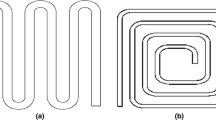Conclusions
-
1.
A study of the distribution of flow parameters, in particular, of the pressure on the wall and in the flow, made it possible to determine the location of the zone of most likely occurrence of cavitation in a penstock. Using these data, we can predict the region of cavitation erosion of the penstock walls.
-
2.
The location of the zone of separation in the bend of a penstock can be determined from the measured profiles of the mean velocity.
-
3.
The investigations established the zones of the disturbing influence of a bend up-and downstream. The length of these zones with respect to mean velocities and pressures was substantially less than the values usually assumed [4, 5]. This permits reducing the distance between the bend and gate apparatus of the turbine, which improves the layout and reduces the cost of constructing the penstock.
-
4.
The proposed empirical formulas for calculating the resistance coefficient of bends with a relative radius of curvature 1≤R/d≤3 agree well with the experimental data of the investigations and [3]. They permit reducing ζ by 20% on average in the range of Reynolds numbers 2×104≤Re≤4×105.
Similar content being viewed by others
Literature cited
A. V. Tananaev, Flows in Channels of MHD Devices [in Russian], Atomizdat, Moscow (1979).
S. S. Agureikin, N. G. Spodyryak, and B. P. Ustimenko, “Experimental investigation of the hydrodynamics of a turbulent flow in curved channels,” Probl. Teploenerg. Prikl. Teplofiz., No. 5 (1969).
H. Ito, “Pressure losses in smooth pipe bends,” Trans. ASME, s. D, No. 1 (1960).
H. Nippert, “∼Uber den Strömungsverlust in gekrummten Kanalen,” Forschungsarbeiten, H. 320 (1929).
F. Wattendorf, “Study of the effect of curvature on fully developed turbulent flow,” Proc. R. Soc., Ser. A,148 (1935).
O. G. Brown and A. W. Morris, “Turbulent water flow in plane curved channels of finite depth,” Teor. Osn. Inzh. Raschetov,85, No. 4 (1963).
B. Agrawal, L. Talbot, and K. Cong, “Laser anemometer study of flow development in curved pipes,” J. Fluid Mech.,85, No. 3 (1978).
G. Taylor, “The criterion for turbulence in curved passages,” Proc. R. Soc., Ser. A,124 (1929).
P. A. Val'ter, “Fluid flow in a curved pipe,” Tr. Gidroenerg. Nauchno.-Issled. Inst., No. 5 (1935).
Additional information
Translated from Gidrotekhnicheskoe Stroitel'stvo, No. 12, pp. 24–28, December, 1984.
Rights and permissions
About this article
Cite this article
Gontsov, N.G., Marinova, O.A. & Tananaev, A.V. Turbulent flow around a bend in a circular pipe. Hydrotechnical Construction 18, 596–602 (1984). https://doi.org/10.1007/BF01440641
Issue Date:
DOI: https://doi.org/10.1007/BF01440641



